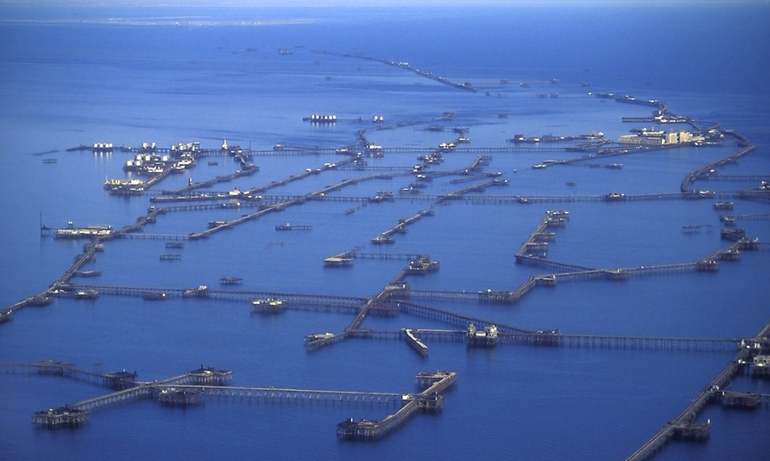It is somewhat paradoxical that the climate summit is being held in the country, which is home to one of the largest engineering projects related to oil. COP29 has started its decisive week in Baku, the capital of Azerbaijan, with the purpose of improving financing from rich countries to the most disadvantaged ones so that they can confront global warming and its consequences. The meeting is being held in a country that is one of the largest gas producers globally and that It is also home to what is known as the floating oil city.a mammoth oil platform that was inaugurated decades ago, but that continues to operate and extract the oil that is housed under the Caspian Sea.
About 110 kilometers east of Baku, in the Azerbaijani sector of the Caspian Sea, is Neft Dalari, also known as Oil Rocks, a floating city built on oil platforms that extend 12 kilometers long and 6 kilometers wide. . What began in 1949 as an ambitious Soviet project to extract oil in shallow waters has become an engineering marvel. recognized by the Guinness Book of Records as the world’s first offshore oil platform. Curiously, the area owes its original name, Black Stones, to the dark color of the rocks that emerge from the sea due to natural oil taps.
Neft Daslari (Oil Rocks in English) It is not only a feat of engineering, but also a human settlement in the middle of the sea. At its peak, it housed more than 5,000 workers, who had a complete infrastructure for their enjoyment and well-being. The city had residential buildings of up to nine floors, a theater with a capacity for 300 people, a library, a bakery, shops, a hospital, a football field and even a green park, created with soil transported from the continent. These facilities provided the inhabitants with a self-sufficient and relatively comfortable living environment in the middle of the sea.
As can be found on the Azarbaijan state oil company’s own website, on November 7, the well produced a gush of oil which marked the world’s first offshore oil production. Azerbaijan is the first to exploit oil fields in the open part of the Caspian Sea, pick up the SOCAR pagethe state oil company of Azerbaijan.
The process was little by little, the platform (or floating city was developed). At first, everything was small conventional platform for crude oil extraction with a small shelter for workers to stay. What began as a single isolated platform began to expand tentacles and new platforms, creating a huge platform with housing blocks. Large constructions began to take place in 1951, giving rise to what some have considered an architectural miracle.
oil production
Oil production at Neft Daslari peaked in the 1960s and 1970s, with daily extraction of up to 100,000 barrels. However, with the passage of time and the depletion of resources, production has decreased significantly. According to data from SOCAR, Azerbaijan’s state oil company, current production is about 21,000 barrels per day.
Those 21,000 barrels barely represent 5% of all the country’s production. Although Azerbaijan’s oil industry has been in decline for several years due to the natural depletion of its deposits, this country continues to pump about 570,000 barrels of crude oil every day, an amount that makes it a net exporter, but which is far from the years in which Baku produced about a million barrels a day.
However, the country’s authorities are making a great effort to attract investment and reverse this trend in production. For now, so far in 2024 they have managed to produce a little more oil in the same period of 2023.

For example, Azerbaijan has welcomed BP’s decision to invest in the country’s fields with great enthusiasm. The British oil company has already started production at a new $6 billion facility in the Azeri-Chirag-Gunashli oil field in Azerbaijan. The modernization of this field can increase the field’s production by up to 25%. The facility, called Azeri-Central-East (ACE), consists of a new production platform 130 kilometers offshore in the Azerbaijani sector of the Caspian Sea (very close to the floating city). ACE currently has a single well drilled to a depth of 3,150 meters and two more wells to be drilled this year, bringing ACE’s daily production to around 24,000 barrels per day, according to BP.
Although new discoveries and deposits are taking the spotlight away from the floating oil city, the truth is that the uniqueness of Neft Daslari has captured the attention of filmmakers and documentary filmmakers. In 2009, Swiss filmmaker Marc Wolfensberger directed the documentary “Oil Rocks: City Above the Sea”which explores the history and peculiar beauty of this floating city on the Caspian Sea.
Over the decades, Neft Daslari has faced significant challenges, including erosion and wear of its structures due to harsh maritime conditions. It is estimated that approximately two-thirds of the original infrastructure has already been rendered useless by sea erosion. However, the city still stands, serving as a testament to Soviet engineering and human determination to exploit natural resources under extreme conditions.
#huge #floating #oil #platform #theater #apartments #soccer #field.. #jet #crude #oil #city
